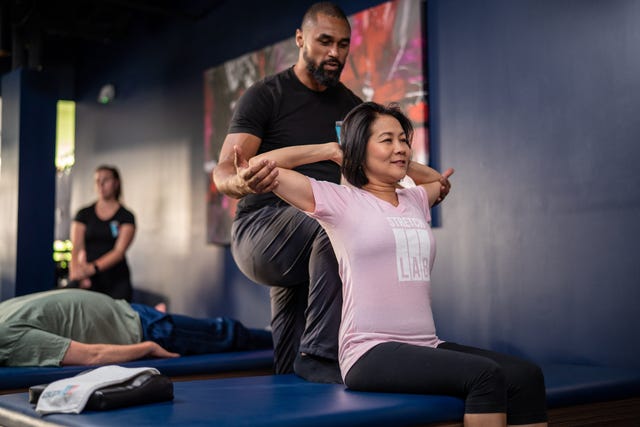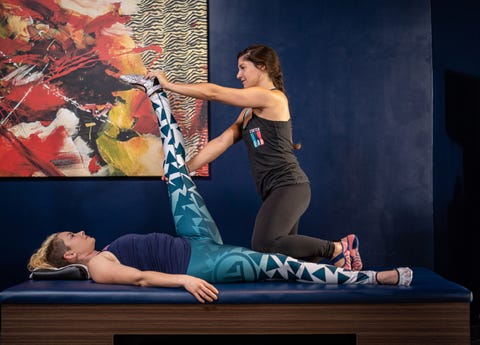Maintaining flexibility is one of the most critical components of exercise to ensure we stay mobile as we age. Stretching studios can help.

Lower-back pain. Neck aches. Shoulder discomfort. If you’re dealing with any of these problems, you might have work-from-home back. With so many people working remotely these days — often on couches or makeshift desks that don’t offer proper ergonomic support — more and more are dealing with new aches and pains.
That’s just one sector of the public that’s helping drive the burgeoning assisted-stretching industry. In the past, you typically needed a referral to a physical therapist — or needed to be a professional athlete — to receive assisted stretching. Today, stretching studios across the country are bringing the service to the masses, providing one-on-one bodywork to those dealing with a wide variety of ailments — without the need for a referral.
On average, sessions last from 30 to 60 minutes and cost anywhere from $40 to $100, per Shape. These studios, including leading brands StretchLab, Motion Stretch, Stretch Pro, and Stretch*d, aim to integrate assisted stretching into the health enthusiast’s overall wellness regimen alongside gym sessions, yoga classes, massage appointments, and the like. In fact, Massage Envy debuted assisted-stretching offerings in recent years to capitalize on the trend.
Lou DeFrancisco, president of StretchLab, which recently signed its 300th franchise agreement, says, “People are re-prioritizing their health and wellness now more than ever and turning to StretchLab to help reclaim the freedom of movement they have been missing, creating an increased sense of ease in daily activities.”
Dr. Leslie J. Waltke, a physical-therapy specialist who focuses on cancer rehabilitation, is glad to see stretching get its turn in the fitness spotlight. “As a physical therapist, I’ve been in the stretching studio, or stretching people, for more than 30 years. Of the three subtypes of exercise — aerobic, strength, and stretching — stretching tends to garner the least amount of attention. That’s why I am thrilled to see the attention drawn to the topic.”
Equally overlooked are the soft tissues in our body, which are targeted during stretching, says Dr. Waltke, founder and CEO of the Waltke Cancer Rehabilitation Academy. Just like our bones, brain, heart, and lungs, our soft tissues need to be kept healthy. “As the human body ages, our soft tissues, which include our skin, connected tissue, fascia, and muscle, tend to shorten and thicken.”
Such tightness and shortening can lead to pain, limited mobility, discomfort, and decreased range of motion, she says. “This may limit daily activity and exercise tolerance and certainly can add wear and tear to local joints. So, from a fitness and health perspective, any person over the age of 30 should be incorporating stretching into their weekly health routine.”
The benefits of stretching are manifold. From a physiological perspective, it can help boost blood flow, treat and prevent back pain, prep for and recover from a workout, enhance flexibility, improve physical performance, prevent tension headaches, increase range of motion, and improve posture. But stretching has mental and emotional benefits too, including busting stress, calming the mind, and serving as a tool for self-care. Finally, for those with illness or injury, stretching can be an integral part of the overall recovery process.
Dr. Waltke notes that there are both short-term and long-term effects of stretching. “Both strength and aerobic exercise have an immediate ‘cost’ involved, like work, effort, and sweat. It takes weeks or months to see the benefits.” Yet there’s immediate gratification from stretching. “Results like feeling looser and more comfortable are often noticeable upon rising from the floor or mat after the stretch session,” she says.
Is it possible to get the same effect stretching at home? Not exactly, says Dr. Waltke. “From a quality perspective, you may get a better stretch if you have someone assist you with your technique.” If you DIY, you might not get the positions quite right and fully reap the benefits, just like with yoga. She also notes that having a plan and an appointment will help you stick with your stretching routine better. “Any time you have an appointment and you have someone waiting for you or expecting you, it’s more likely that you’re going to follow through with that particular exercise.”
If you’re wondering if stretching might benefit you, Dr. Waltke has a ready reply: “The answer is most likely yes. Whether young or old, fit or unfit, active or inactive, there is compelling evidence that stretching even just twice weekly will improve your comfort, function, and health.”

Let’s say you already do some stretching at home but aren’t sure if assisted stretching would help you. There are several reliable ways to test your flexibility at home with little or no equipment, Dr. Waltke says. One involves sitting on the floor and getting back up again. But it’s not quite that simple. For this sitting-rising test, developed by a Brazilian doctor (per CNN), take off your shoes and socks. From a standing position, sit down on the floor by using your arms, legs, and hands for support as little as possible. Then, try to stand up, using as little support as you can. “Give yourself a score of 5 if you sat with no support at all and 5 if you got up without support. For each support required, such as a hand, forearm, knee, side of a leg, or hand on a knee, subtract 1 point. Subtract a half-point if you were wobbly sitting or standing.” Didn’t fare so well? It might be time to make a stretching appointment.
If you’re convinced about assisted stretching and looking for the best studio in your area, Dr. Waltke has some pointers. “In choosing a particular studio, the most important component of any fitness studio or facility is the professionals that work there,” she says. “The staff should hold some type of certification in that specialty.” But there’s one caveat: Certification does not always correlate with experience or expertise. “It is also very important to ensure that any professional you work with, you feel you connected with them as a person, they communicate well, they educate you well, and they listen to your concerns and needs to help build a program or plan that’s best for you.”
View full article here.
%20(4).png?width=2500&height=486&name=XPO%202023%20logo-02%20(1)%20(4).png)